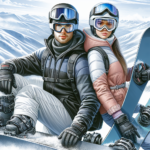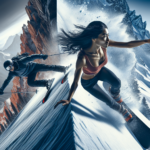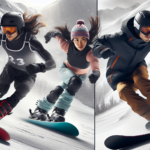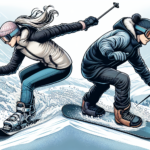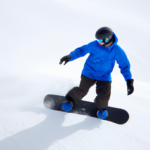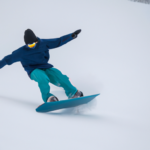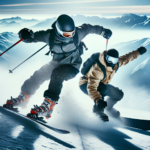If you’ve ever sat at the top of a slope, snowboard or skis strapped to your feet, you’ve probably asked yourself: is snowboarding really more difficult than skiing? In this article, you’ll find a comprehensive comparison between the two, taking into consideration factors like learning curve, physical effort, risk of injury, and more. You might just gain a new perspective on these popular winter sports.
Understanding Basic Differences Between Skiing And Snowboarding
Get ready, because we’re going to dive straight into the snowy world of skiing and snowboarding. Let’s kick off with some essentials.
Skiing essentials
Skiing, a classic winter sport, originated from prehistoric times when it was used as a means of transport over snow-covered grounds. As a skier, you take on the slopes with two long skis attached to your boots, and you’ll usually use ski poles for balance and support. The idea is to slide downhill in a standing posture, so brace yourself!
Snowboarding essentials
Snowboarding is a bit of a fresh-faced newcomer in comparison, having emerged in the 1960s. It involves riding down a snow-covered slope while standing on a board attached to your feet. Unlike skiing, no poles are involved, and both feet are bound to the same board. Think of surfing, but on snow.
Equipment differences
Aside from the obvious boots and skis or a snowboard, different goggles, helmets and clothing requirements also distinguish skiing from snowboarding. Skiers usually opt for tight-fitted clothing for better aerodynamics, while snowboarders gear up in looser outfits for wider movement range.
Body Movements in Skiing Vs Snowboarding
The way you move your body in both these sports can be a major game-changer.
Basic body posture in skiing
In skiing, your body is mostly faced forward, aligned to your skis just like the way you stand naturally, and your legs should be parallel to each other.
Basic body posture in snowboarding
In contrast, snowboarding involves a sideways stance, with your body parallel to the board. Picture how a surfer stands on their surfboard. Your feet are strapped side by side and you have to turn your head to see where you’re heading, which might take some getting used to.
Movement control while skiing
In skiing, you control your movement and speed by shifting your weight, leaning into turns, and using your poles. Piece of cake, right?
Movement control while snowboarding
Snowboarding, however, requires you to shift your weight on the board by flexing your ankles and moving your hips. This requires a bit more balance and body coordination, but it’s doable with some practice!
Learning Curve in Skiing vs Snowboarding
Next up, let’s examine the learning curves.
Initial learning phase of skiing
Skiing might seem more approachable at the start, with beginners typically getting the hang of the basics in a couple of days.
Initial learning phase of snowboarding
Compared to skiing, snowboarding may take a few more days to get past the beginner stage as it can be hard to keep your balance on one board.
Progression speed in skiing
Once you’ve mastered the fundamentals of skiing, the progression phase becomes steeper and more challenging.
Progression speed in snowboarding
Snowboarding, on the other hand, might be tough to begin with, but once you’ve got a feel for it, you tend to progress at a quicker pace.
Physical Challenges in Skiing versus Snowboarding
Oh boy, don’t think we forgot about the physical challenges. Spoiler alert: there are plenty!
Physical fitness required for skiing
Skiing demands good cardiovascular fitness and strong lower body muscles. Your quads, hamstrings and hips will be doing most of the work.
Physical fitness required for snowboarding
Snowboarding primarily works your core and leg muscles, and it requires a higher level of fitness, especially for balance and stability.
Common injuries in skiing
In skiing, most common injuries are to the knees, due to the twisting motion and extra strain from controlling two separate skis.
Common injuries in snowboarding
In snowboarding, wrist, shoulder and ankle injuries are common, due to frequent falls, especially during the learning phase.
Accessibility and Cost Requirements
What about cost and access?
Skiing equipment and cost
Skiing gear can be slightly less expensive and more available to rent at most winter resorts.
Snowboarding equipment and cost
On the other hand, snowboarding gear could be a little more on the costly side, but not by much, and it is increasingly readily available to rent as well.
Accessibility of skiing
Skiing has been the elite winter sport for a long time, and as such, it’s generally more accessible across the globe.
Accessibility of snowboarding
Although snowboarding has been around for a shorter period of time, it’s gained massive popularity quickly, and now, it’s pretty much available wherever skiing is.
Terrain Differences in Skiing and Snowboarding
We’ll get a little more specific now, and talk about navigating different terrains.
Skiers can easily navigate flat or uphill terrain using their poles for propulsion.
Snowboarders might struggle a bit in flat areas or uphill slopes due to the lack of poles and having both feet strapped to the board, which can make pushing off the ground difficult.
Negotiating moguls in skiing
Skiers can negotiate moguls (small, artificial bumps on slopes) with more precision due to the flexibility of having two separate skis.
Negotiating moguls in snowboarding
Snowboarders may face a challenge here, as turning and maintaining balance on moguls can be quite demanding!
Flexibility in Skiing vs Snowboarding
Let’s talk flexibility and how it influences your speed and turns.
Turning flexibility in skiing
Skiing can offer greater turning flexibility due to the ability to independently maneuver each ski.
Turning flexibility in snowboarding
In snowboarding, you need to move your entire body to change direction which can be difficult for beginners.
Speed control in skiing
For skiers, speed control is typically easier because you can use both skis and poles to control your descent.
Speed control in snowboarding
In snowboarding, controlling speed involves a bit more skill as you have to use your board’s edges and body shifting, which takes practice.
Exploring The Fear Factor
Fear factor plays a huge role in learning and mastering these sports.
Fear while learning skiing
In skiing, beginners may fear high speeds and steep slopes. The fear of losing control is quite common.
Fear while learning snowboarding
For snowboarding beginners, the fear usually revolves around getting injured during falls which can be frequent during the initial learning phase.
Coping with fear in both sports
However, fear is natural and can be mitigated with proper coaching, practice, and protective gear. It’s all about building your confidence gradually.
Family Friendliness of Skiing and Snowboarding
Lastly, if you’re thinking of getting the whole family involved, here’s some useful information.
Starting age for skiing
Children can generally start skiing as young as 3 years old since it involves a more natural standing position.
Starting age for snowboarding
For snowboarding, it’s generally recommended that children start at 6 years old or older due to the need for greater strength and balance.
Adult beginners in skiing
For adult beginners, skiing tends to be easier to pick up because of the familiar body positioning.
Adult beginners in snowboarding
For adults learning to snowboard, even though it might be tougher initially, you can expect a faster progression once you get the basics down.
Conclusion: Is Snowboarding More Difficult Than Skiing?
Weighing everything up, let’s answer that burning question.
Summarizing the complexities in skiing
Skiing can seem easier to learn initially but progressing to advanced levels can be challenging. It provides more control and stability, but navigating complex terrains and achieving high speeds requires lots of practice and skill.
Summarizing the complexities in snowboarding
Snowboarding might have a steeper initial learning curve and requires a fine balance. But once the initial phase is overcome, progression often seems quicker and you have an enhanced freedom of movement over skis.
Personal factors affecting the difficulty level
At the end of the day, whether skiing or snowboarding is harder depends on your personal fitness level, perseverance, and to some extent, your fear factor! Both sports are challenging and rewarding in their own ways, so why not try both and see which one feels right for you?
And remember, the mountains can’t conquer themselves; it’s all about getting out there and embracing the winter!
- What Snowboard Bindings Should I Get? - January 23, 2024
- What Size Screws For Snowboard Bindings? - January 23, 2024
- How To Snowmobile On Water? - January 23, 2024



